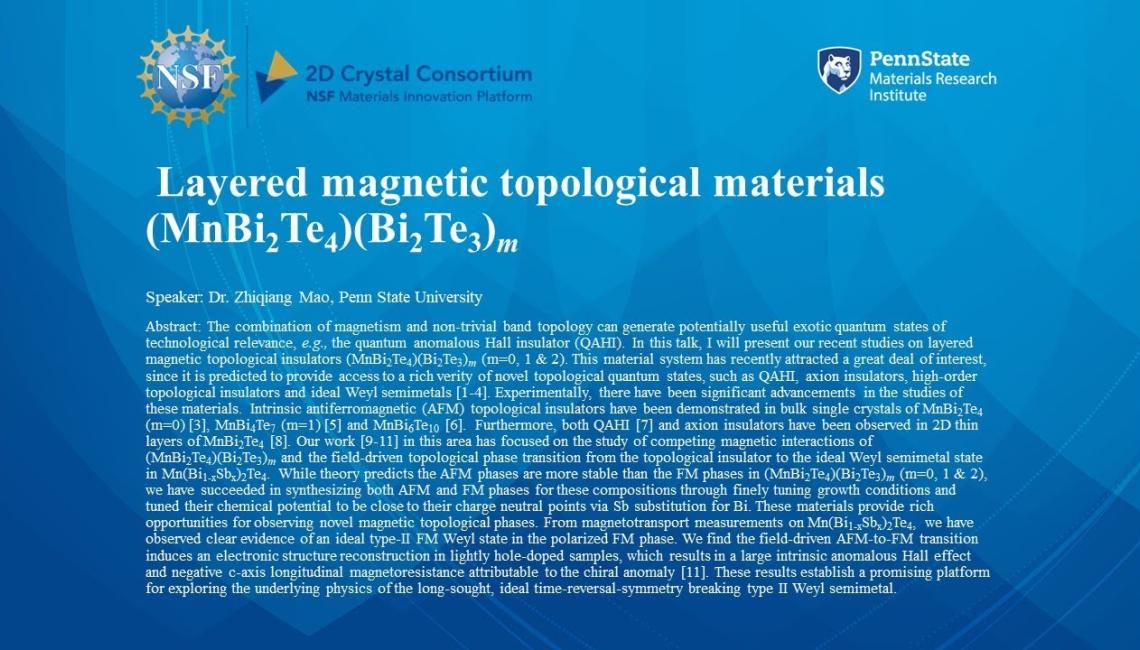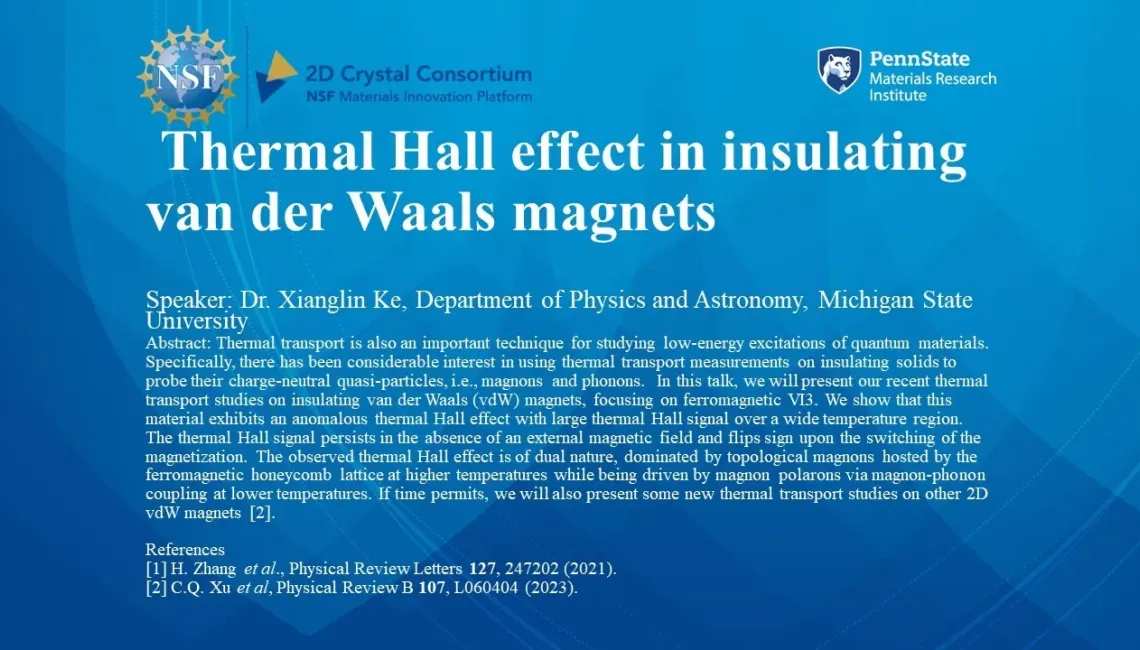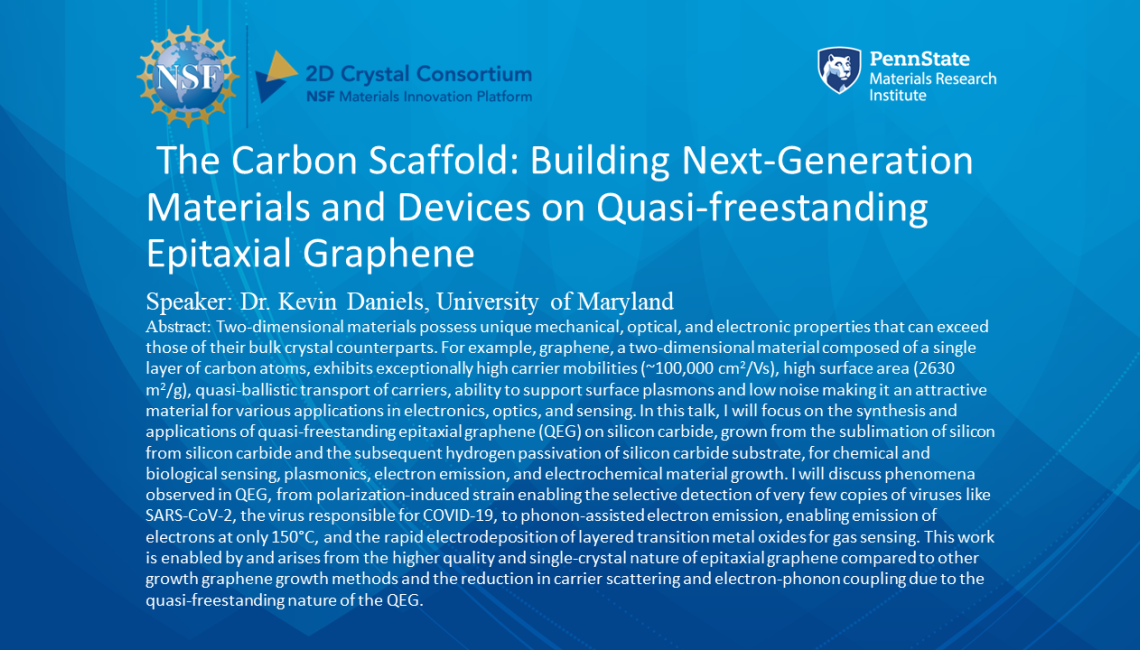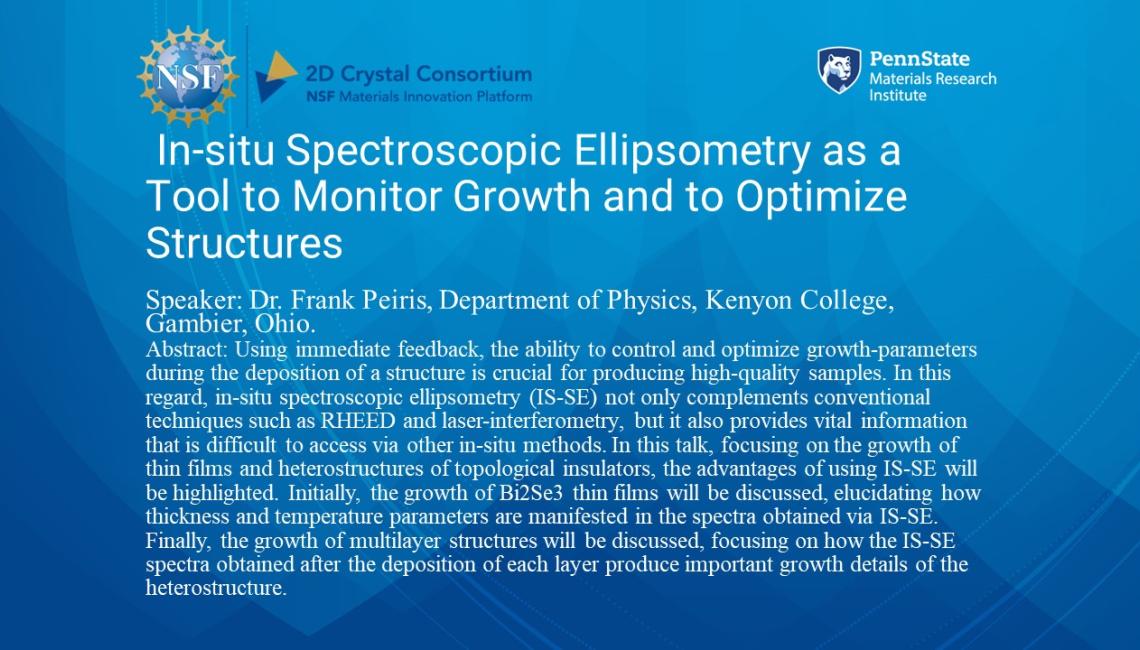Advances in superconductor-semiconductor hybrid systems for quantum devices
Thursday November 30, 2023 from 12-1pm ET
Speaker: Dr. Joon Sue Lee, UT-Knoxville
Abstract: In superconductor-semiconductor hybrid systems, achieving interfaces and junctions with minimal disorder is crucial for realizing quantum phenomena associated with induced superconductivity, towards application in quantum technologies. Advances in the development of transparent interfaces by molecular beam epitaxy and clean junctions via in-situ shadowing have resulted in enhanced features of superconducting proximity effect. These schemes of in-situ deposition and shadowing of superconductors extend to quantum devices based on 1D nanowires, selectively grown in-plane 1D wires, and 2D electron gases. Furthermore, these approaches broaden the selection of superconductors by eliminating the need for selective etching of superconductors on semiconductors. In this talk, materials and devices prepared by in-situ deposition and shadowing will be demonstrated, accompanied by discussions on relevant electrical transport studies. Additionally, I will delve into the recent utilization of Sn in superconductor-semiconductor systems and the control of structural phases of Sn when grown on semiconductors.
Spontaneous breaking of rotational and time-reversal symmetry in multi-layer graphene
Thursday October 19, 2023 from 12-1pm ET
Speaker: Dr. Leo Li, Brown University
Abstract: The low-temperature phase diagram of multi-layer graphene offers an ideal venue to investigate the complex interplay between Coulomb interaction, broken symmetries, and nontrivial band topology. For instance, recent theoretical predictions shed light on a new type of Coulomb-driven instability in the momentum space of bilayer graphene, which breaks rotational and time-reversal symmetry simultaneously. Here, I utilize the angle-resolved measurement of transport nonreciprocity to examine the nature of spontaneous symmetry breaking in multi-layer graphene. By analyzing the angular dependence of nonreciprocity in both longitudinal and transverse channels, we directly identify the mirror plane of the underlying electronic order, which offers unambiguous evidence for spontaneous in-plane rotational symmetry breaking. By investigating the interplay between transport nonreciprocity, ferromagnetism, and superconductivity, we uncover a direct link between spontaneous breaking of rotational and time-reversal symmetry in multi-layer graphene. Combined, our findings suggest that the exchange-driven instability in the momentum space plays a key role in defining the landscape of emergent phenomena in multilayer graphene.
Data-Driven Computational Synthesis of 2D van der Waals Materials with Organic Molecules
Thursday September 28, 2023 from 12-1pm ET
Speaker: Dr. Chinedu Ekuma, Lehigh University
Abstract: The dawn of machine learning and materials informatics has ushered in a new era of data-driven materials design and discovery. As we delve into the expansive computational space of materials properties, these data-centric methodologies offer a streamlined approach, efficiently pinpointing regions of interest and predicting promising candidates. This not only accelerates the discovery process but also reduces computational costs significantly. A prime example of this advancement is in the exploration of 2D van der Waals materials. When integrated with organic molecules, these materials showcase promising and novel properties. Through a data-driven lens, we can expedite the identification and optimization of these hybrid systems, moving us closer to real-world applications. This talk will shed light on how machine learning and materials informatics are paving the way for innovative materials design, with a special emphasis on the interplay between 2D van der Waals materials and organic molecules.
Biography: Prof. Ekuma earned his Ph.D. in Physics from Louisiana State University under Prof. Mark Jarrell. After roles at the U.S. Army Research Laboratory and the U.S. Naval Research Laboratory, he joined the Lehigh University faculty in 2019. His research focuses on strongly correlated materials, exploring the dynamics between strong interactions and nanoscale defects. His methodologies include materials informatics, machine learning, ab initio density functional theory, and many-body approaches, which he uses to investigate and design emerging material properties.
The Carbon Scaffold: Building Next-Generation Materials and Devices on Quasi-freestanding Epitaxial Graphene
Thursday May 4, 2023 from 12-1pm ET
Speaker: Dr. Kevin Daniels, University of Maryland
Abstract: Two-dimensional materials possess unique mechanical, optical, and electronic properties that can exceed those of their bulk crystal counterparts. For example, graphene, a two-dimensional material composed of a single layer of carbon atoms, exhibits exceptionally high carrier mobilities (~100,000 cm2/Vs), high surface area (2630 m2/g), quasi-ballistic transport of carriers, ability to support surface plasmons and low noise making it an attractive material for various applications in electronics, optics, and sensing. In this talk, I will focus on the synthesis and applications of quasi-freestanding epitaxial graphene (QEG) on silicon carbide, grown from the sublimation of silicon from silicon carbide and the subsequent hydrogen passivation of silicon carbide substrate, for chemical and biological sensing, plasmonics, electron emission, and electrochemical material growth. I will discuss phenomena observed in QEG, from polarization-induced strain enabling the selective detection of very few copies of viruses like SARS-CoV-2, the virus responsible for COVID-19, to phonon-assisted electron emission, enabling emission of electrons at only 150°C, and the rapid electrodeposition of layered transition metal oxides for gas sensing. This work is enabled by and arises from the higher quality and single-crystal nature of epitaxial graphene compared to other growth graphene growth methods and the reduction in carrier scattering and electron-phonon coupling due to the quasi-freestanding nature of the QEG.
Biography: Dr. Kevin Daniels is an Assistant Professor of Electrical and Computer Engineering and the Institute for Electronics and Applied Physics at the University of Maryland, College Park, and director of the Dimensional Materials Laboratory (DML), which focuses on exploiting the electrical, optical, and mechanical properties of 2D and low-dimensional materials synthesized in the lab for chemical and biological sensing, quantum science and plasmonics. He received his B.S., M.E., and Ph.D. from the University of South Carolina in 2009, 2012, and 2014 respectively. Before joining the University of Maryland faculty in 2017, he was a National Research Council Postdoctoral Fellow residing at the U.S. Naval Research Laboratory from 2014-2017, receiving postdoctoral training from Rachael Myers-Ward and Kurt Gaskill. He is a National Science Foundation CAREER award (2022) recipient, and his scientific contributions have led to 40 publications in 2D and wide bandgap semiconductor material synthesis, characterization, and applications.
Thermal Hall effect in insulating van der Waals magnets
Thursday March 30, 2023 from 12-1pm ET
Speaker: Dr. Xianglin Ke, Michigan State University
Abstract: Thermal transport is also an important technique for studying low-energy excitations of quantum materials. Specifically, there has been considerable interest in using thermal transport measurements on insulating solids to probe their charge-neutral quasi-particles, i.e., magnons and phonons. In this talk, we will present our recent thermal transport studies on insulating van der Waals (vdW) magnets, focusing on ferromagnetic VI3. We show that this material exhibits an anomalous thermal Hall effect with large thermal Hall signal over a wide temperature region. The thermal Hall signal persists in the absence of an external magnetic field and flips sign upon the switching of the magnetization. The observed thermal Hall effect is of dual nature, dominated by topological magnons hosted by the ferromagnetic honeycomb lattice at higher temperatures while being driven by magnon polarons via magnon-phonon coupling at lower temperatures. If time permits, we will also present some new thermal transport studies on other 2D vdW magnets [2].
References
[1] H. Zhang et al., Physical Review Letters 127, 247202 (2021).
[2] C.Q. Xu et al, Physical Review B 107, L060404 (2023).
In-situ Spectroscopic Ellipsometry as a Tool to Monitor Growth and to Optimize Structures
Thursday February 23, 2023 from 12-1pm ET
Speaker: Dr. Frank Peiris, Kenyon College
Abstract: Using immediate feedback, the ability to control and optimize growth-parameters during the deposition of a structure is crucial for producing high-quality samples. In this regard, in-situ spectroscopic ellipsometry (IS-SE) not only complements conventional techniques such as RHEED and laser-interferometry, but it also provides vital information that is difficult to access via other in-situ methods. In this talk, focusing on the growth of thin films and heterostructures of topological insulators, the advantages of using IS-SE will be highlighted. Initially, the growth of Bi2Se3 thin films will be discussed, elucidating how thickness and temperature parameters are manifested in the spectra obtained via IS-SE. Finally, the growth of multilayer structures will be discussed, focusing on how the IS-SE spectra obtained after the deposition of each layer produce important growth details of the heterostructure.
Layered magnetic topological materials (MnBi2Te4)(Bi2Te3)m
Thursday January 26, 2023 from 12-1pm ET
Speaker: Dr. Zhiqiang Mao, Penn State University
Abstract: The combination of magnetism and non-trivial band topology can generate potentially useful exotic quantum states of technological relevance, e.g., the quantum anomalous Hall insulator (QAHI). In this talk, I will present our recent studies on layered magnetic topological insulators (MnBi2Te4)(Bi2Te3)m (m=0, 1 & 2). This material system has recently attracted a great deal of interest, since it is predicted to provide access to a rich verity of novel topological quantum states, such as QAHI, axion insulators, high-order topological insulators and ideal Weyl semimetals [1-4]. Experimentally, there have been significant advancements in the studies of these materials. Intrinsic antiferromagnetic (AFM) topological insulators have been demonstrated in bulk single crystals of MnBi2Te4 (m=0) [3], MnBi4Te7 (m=1) [5] and MnBi6Te10 [6]. Furthermore, both QAHI [7] and axion insulators have been observed in 2D thin layers of MnBi2Te4 [8]. Our work [9-11] in this area has focused on the study of competing magnetic interactions of (MnBi2Te4)(Bi2Te3)m and the field-driven topological phase transition from the topological insulator to the ideal Weyl semimetal state in Mn(Bi1-xSbx)2Te4. While theory predicts the AFM phases are more stable than the FM phases in (MnBi2Te4)(Bi2Te3)m (m=0, 1 & 2), we have succeeded in synthesizing both AFM and FM phases for these compositions through finely tuning growth conditions and tuned their chemical potential to be close to their charge neutral points via Sb substitution for Bi. These materials provide rich opportunities for observing novel magnetic topological phases. From magnetotransport measurements on Mn(Bi1-xSbx)2Te4, we have observed clear evidence of an ideal type-II FM Weyl state in the polarized FM phase. We find the field-driven AFM-to-FM transition induces an electronic structure reconstruction in lightly hole-doped samples, which results in a large intrinsic anomalous Hall effect and negative c-axis longitudinal magnetoresistance attributable to the chiral anomaly [11]. These results establish a promising platform for exploring the underlying physics of the long-sought, ideal time-reversal-symmetry breaking type II Weyl semimetal.
References:
[1] D. Zhang et al., Phys. Rev. Lett. 122, 206401 (2019).
[2] J. Li et al., Science Advances 5, eaaw5685 (2019).
[3] M. M. Otrokov et al., Nature 576, 416 (2019).
[4] R.X. Zhang, F.C.Wu & S.D. Sarma, Phys. Rev. Lett. 124, 136407 (2020)
[5] C. Hu, et al., Nat. Commun. 11, 1 (2020).
[6] S. Tian et al., Phys. Rev. B 102, 035144 (2020
[7] Y. Deng et al., Science 367, 895 (2020)
[8] C. Liu et al., Nat. Mater. 19, 5 (2020
[9] Lee et al., Phys. Rev. Research 1, 012011(R) (2019).
[10] Y.Y. Chen et al., Phys. Rev. Materials 4, 064411(2020).
[11] Lee et al., Phys. Rev. X 11, 031032 (2021).



